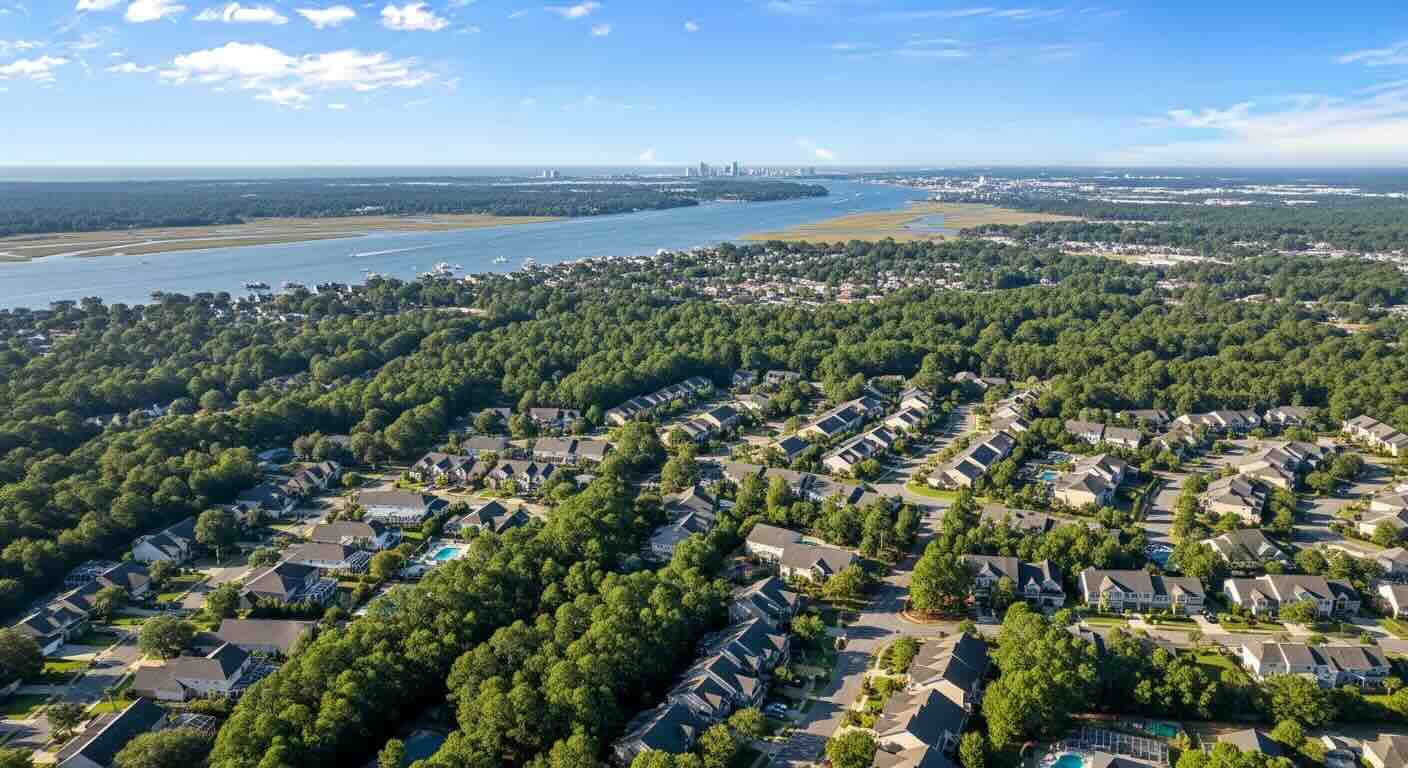The move from Los Angeles to Myrtle Beach represents one of the fastest-growing migration patterns in the country, driven by families seeking ocean access, lower housing costs, and a pace of life that feels manageable instead of relentless. For decades, California families endured rising property taxes, million-dollar starter homes, and traffic that turned a 12-mile commute into a 90-minute ordeal.
Myrtle Beach offers a reset: beachfront living at a fraction of the cost, neighborhoods where kids can play outside without constant supervision, and the ability to own a single-family home on a middle-class income.
This guide walks through what changes when you make the 2,500-mile journey from the West Coast to the Southeast, covering the practical logistics of a cross-country move and the longer-term adjustments in climate, culture, cost of living, and daily routine. Whether you’re relocating for a job, following family, or simply prioritizing affordability and beach access, understanding the differences up front helps you plan better and settle in with fewer surprises.
The Story of the California Exodus Meets NC Shores
The California-to-South-Carolina migration picked up momentum in the 2010s and accelerated dramatically during and after the COVID-19 pandemic. Remote work untethered families from expensive coastal cities, revealing what many had suspected for years: you don’t need to live in Los Angeles to earn Los Angeles money, and the quality of life trade-offs that once felt necessary, hour-long commutes, $800,000 for a modest three-bedroom, fire season smoke and water restrictions, suddenly felt optional.
Myrtle Beach became an unexpected beneficiary of this exodus. It’s not as culturally established as Charleston or as inland as Greenville, but it offers something those cities don’t: 60 miles of Atlantic coastline, warm water beaches accessible nine months a year, and housing prices that make California transplants do a double-take. A family selling a 1,200-square-foot bungalow in Culver City for $1.2 million can buy a 2,500-square-foot single-family home with a yard, garage, and pool in Carolina Forest for $450,000 and still have $700,000 in equity left over. That math changes everything.
The typical story goes like this: a couple in their 30s or 40s with school-age kids realizes they’re paying $4,000 a month for a two-bedroom rental with no yard and no path to ownership. One spouse’s company goes fully remote. They start researching affordable coastal areas outside California and stumble across Myrtle Beach. The beaches look real, the schools in Carolina Forest and Socastee have solid ratings, and the cost of living calculator shows they could cut monthly expenses by 40 percent while upgrading to a house. They visit once in spring, fall in love with the slower pace and Southern hospitality, and list their California place within six months.
Myrtle Beach has absorbed this wave quickly. Entire neighborhoods in Carolina Forest are now filled with California license plates and former West Coasters comparing notes about how strange it is to pump your own gas or how much they miss In-N-Burger. The local real estate market has responded: new construction developments target families moving from high-cost states, emphasizing large lots, modern floor plans, and amenities like community pools and playgrounds. It’s not quite California, but it’s coastal, affordable, and family-friendly, which turns out to be exactly what thousands of Californians were looking for all along.
Key Points
- Long-distance moving costs from LA to Myrtle Beach range from $5,000 to $12,000 for a typical two to three-bedroom household, depending on volume, season, and service level; add vehicle shipping ($1,200 to $1,800), storage, or packing services to the upper end.
- Median home prices in Myrtle Beach hover around $365,000 to $370,000, compared to over $1 million in Los Angeles; families often cut housing costs by 50 to 60 percent while gaining square footage, yards, and newer construction.
- South Carolina has lower property taxes than California (0.5 to 0.6 percent effective rate vs. 0.7 to 1 percent), but homeowners insurance costs more due to hurricane risk ($1,500 to $3,500 annually).
- Myrtle Beach beaches are warm-water Atlantic coast with seasonal swimming (May through October); California’s Pacific is colder year-round but offers better surf and more dramatic coastline.
- Car ownership remains essential in both locations, but Myrtle Beach traffic is lighter, commutes are shorter (10 to 20 minutes typical), and parking is abundant and often free.
- Carolina Forest, Socastee, and The Market Common are the top family-friendly neighborhoods with good schools, parks, and community amenities; avoid older coastal areas prone to flooding.
Distance, Route, and Cross-Country Moving Logistics
Los Angeles to Myrtle Beach covers approximately 2,500 to 2,540 miles depending on your exact origin and destination. The drive typically takes 37 to 40 hours of actual driving time, spread over four to five days in a personal vehicle. The most common route follows I-10 East through Arizona, New Mexico, and Texas, then picks up I-20 through Louisiana, Mississippi, and Alabama, shifts to I-59 and I-85 through Georgia, and finally I-26 and US-501 into South Carolina.
For professional movers, this is a multi-day coast-to-coast haul requiring a long-distance moving company licensed by the Federal Motor Carrier Safety Administration (FMCSA). Most moves load in LA over one to two days, travel for 4 to 7 days depending on routing and whether your shipment is consolidated with other customers’ belongings, and unload in Myrtle Beach within a delivery window (typically 7 to 14 business days, sometimes longer during peak summer season).
Timing matters significantly. Peak moving season (May through September) overlaps with Myrtle Beach’s busiest tourist months and hurricane season, which drives prices up and availability down. Many California families prefer moving in late fall or early spring (October through April) to avoid summer heat, tourist crowds, and peak rates. This timing also aligns better with school calendars, allowing kids to finish the academic year in California and start fresh in South Carolina in the fall.
Vehicle Transport
Most families ship at least one vehicle rather than driving multiple cars cross-country. Open carrier transport (your car loaded onto a multi-level truck with other vehicles) costs $1,200 to $1,600 for the LA-to-Myrtle Beach route and takes 7 to 10 days. Enclosed transport (protected from weather and road debris) runs $2,000 to $2,800 and is worth considering for luxury or classic cars. Book vehicle transport 4 to 6 weeks in advance, especially during peak season.
Storage and Timing Gaps
If your California lease ends before your South Carolina home is ready, or if you’re buying and need to close before moving in, short-term storage becomes necessary. Many long-distance movers offer storage-in-transit (your belongings stay in the moving company’s warehouse) for $200 to $500 per month depending on volume. Alternatively, rent a storage unit in Myrtle Beach for $100 to $250 per month and have the movers deliver directly there.
What It Costs to Move from Los Angeles to Myrtle Beach
Cross-country moving costs depend on household volume (measured in cubic feet or weight), services included, and time of year. Here are typical ranges for 2025:
| Household Size | Estimated Cost (Labor + Transport) | Notes |
|---|---|---|
| Studio or 1-bedroom apartment | $3,500 to $6,500 | Approximately 400 to 700 cubic feet; delivery window 7 to 14 days. |
| 2-bedroom apartment or small house | $5,500 to $9,500 | Approximately 1,000 to 1,400 cubic feet; add $1,500 to $2,500 for full packing. |
| 3-bedroom house | $8,000 to $14,000 | Approximately 1,600 to 2,200 cubic feet; stairs and long carries add cost. |
| 4+ bedroom house | $12,000 to $20,000+ | Large volume; may require shuttle or split shipments if exceeding truck capacity. |
Additional costs include packing services ($1,200 to $3,500 depending on household size), Full Value Protection insurance (1 to 2 percent of declared value, highly recommended for cross-country moves), vehicle transport ($1,200 to $1,800 for open carrier, $2,000 to $2,800 for enclosed), storage-in-transit if there’s a gap between move-out and move-in dates ($200 to $500 per month), and temporary housing or hotels during the cross-country drive if you’re not flying ($600 to $1,200 for 4 to 5 nights).
Peak season rates (May through August) run 20 to 40 percent higher than off-season. Booking 8 to 12 weeks ahead gives you better crew availability and pricing, especially if you’re flexible on exact delivery dates.
Cost of Living: Los Angeles vs. Myrtle Beach
The cost-of-living difference is the primary driver of this migration. Myrtle Beach is approximately 40 to 50 percent less expensive than Los Angeles overall, with housing accounting for most of that gap.
| Expense Category | Los Angeles | Myrtle Beach |
|---|---|---|
| Median home price | $1,000,000 to $1,200,000 | $365,000 to $370,000 |
| Median rent (2-bedroom) | $2,800 to $3,500/month | $1,400 to $1,800/month |
| Property tax (annual, avg home) | $7,000 to $12,000 | $2,000 to $3,500 |
| Homeowners insurance (annual) | $1,200 to $2,000 | $1,500 to $3,500 (hurricane risk) |
| Utilities (electric, water, internet) | $200 to $300 | $240 to $350 (A/C runs May through Oct) |
| Groceries (monthly, family of 4) | $900 to $1,200 | $800 to $1,000 |
| Gasoline (per gallon) | $4.50 to $5.50 | $2.80 to $3.20 |
| Dining out (casual meal for family of 4) | $80 to $120 | $50 to $80 |
| Car insurance (annual, full coverage) | $2,000 to $2,800 | $1,400 to $1,900 |
| Childcare (monthly, full-time daycare) | $1,500 to $2,500 per child | $800 to $1,200 per child |
Housing Reality Check
The housing difference is staggering. A modest three-bedroom, two-bath home in LA’s suburbs (think Torrance, Burbank, or Pasadena) runs $900,000 to $1.2 million. That same budget buys a brand-new 2,500-square-foot home with a yard, pool, and three-car garage in Carolina Forest or a waterfront property in one of Myrtle Beach’s gated communities. Most California families downsize their mortgage payment by 50 to 60 percent while upgrading their living space significantly.
Tax Considerations
California’s state income tax ranges from 1 to 13.3 percent (the highest in the nation), while South Carolina’s tops out at 6.5 percent. For a family earning $150,000 annually, the state tax savings alone can be $5,000 to $8,000 per year. South Carolina also has lower sales tax (6 to 9 percent combined state and local vs. California’s 7.25 to 10.75 percent) and no tax on Social Security income, which benefits retirees.
However, property tax structures differ. California’s Proposition 13 caps annual property tax increases at 2 percent, while South Carolina reassesses properties regularly, allowing for larger jumps if home values rise. Over time, this can erode some of the initial savings, though South Carolina’s lower base rates still favor most homeowners.
Where to Live: Family-Friendly Neighborhoods in Myrtle Beach
Choosing the right neighborhood matters, especially for families with school-age children. Here are the top areas around Myrtle Beach California transplants gravitate toward:
Carolina Forest

Carolina Forest is the number-one choice for families moving to Myrtle Beach. Located inland (about 10 to 15 minutes from the beach), this sprawling master-planned community offers top-rated schools (Carolina Forest Elementary, River Oaks Elementary, Ten Oaks Middle), safe streets, sidewalks, parks, and a strong sense of community. Homes range from $350,000 for older three-bedroom models to $600,000+ for new construction with pools and large lots.
The area feels suburban in the best sense: quiet cul-de-sacs, neighborhood pools, walking trails, and families who know each other. Many California transplants say it reminds them of Orange County suburbs from the 1990s before prices skyrocketed.
The Market Common
The Market Common is Myrtle Beach’s walkable, mixed-use neighborhood built on the site of a former Air Force base. It features tree-lined streets, locally owned shops, restaurants, a movie theater, parks, and a strong community vibe. Homes and townhomes range from $400,000 to $800,000, with condos starting around $250,000.
This neighborhood appeals to families who want urban conveniences (walkability, dining, events) without the tourist chaos of the beachfront. Schools in the area (Ocean Bay Elementary, Ocean Bay Middle) are solid, and the community hosts regular farmers markets, concerts, and family events.
Socastee
Socastee sits just inland from the Intracoastal Waterway and offers a mix of established neighborhoods and newer developments. It’s zoned for Socastee High School (one of the area’s larger 5A schools) and provides good value: three-bedroom homes range from $300,000 to $500,000. The area is more working-class and less polished than Carolina Forest but offers strong community ties and convenient access to shopping and highways.
Grande Dunes

For families with larger budgets, Grande Dunes offers luxury living with ocean access, top-tier golf courses, private marina, and upscale amenities. Homes start around $700,000 and climb into the millions for oceanfront properties. The neighborhood feels resort-like year-round, with gated security, pristine landscaping, and proximity to high-end dining and shopping.
Areas to Avoid or Approach Cautiously
Older beachfront neighborhoods (north of Myrtle Beach proper, closer to North Myrtle Beach) often deal with flooding, aging infrastructure, and tourist-heavy traffic. Homes may be cheaper ($200,000 to $350,000), but hurricane damage risk, flood insurance costs, and proximity to transient vacation rentals create long-term headaches. Families prioritizing stability and good schools should focus on inland communities like Carolina Forest and Socastee.
Beaches and Climate: What Changes from California
Beach Access and Quality

Myrtle Beach offers 60 miles of sandy Atlantic coastline with warm water and gentle waves. Swimming season runs May through October, with water temperatures reaching the mid-70s to low 80s in summer. The beaches are wide, flat, and family-friendly, with lifeguards at major access points and ample parking (though much of it is paid during peak season).
California beaches, by contrast, offer colder Pacific water (rarely above 70°F even in summer), better surf, more dramatic coastline with cliffs and rock formations, and year-round access without the seasonal tourism crush. Los Angeles beaches like Malibu, Manhattan Beach, and Laguna offer world-class beauty and surf culture that Myrtle Beach can’t match.
The tradeoff is accessibility and cost. Myrtle Beach’s beaches are free or low-cost to access, parking is abundant, and the water is warm enough for kids to swim comfortably for hours. California beaches require permits, deal with heavy crowds, and often involve hiking or difficult parking.
long distance moves
as low as $1748
Long-distance moving all across the United States. Experienced and insured, residential and commercial.
4.9/5 AVERAGE RATING
Climate Comparison
| Season | Los Angeles | Myrtle Beach |
|---|---|---|
| Winter (Dec-Feb) | Mild, 55 to 70°F; occasional rain; no snow. | Cool, 40 to 60°F; some rain; rare light snow. |
| Spring (Mar-May) | Perfect, 60 to 75°F; dry; beach season starts. | Pleasant, 60 to 78°F; blooming season; beach warming up. |
| Summer (Jun-Aug) | Warm, 70 to 85°F; dry heat; no humidity; perfect beach weather. | Hot and humid, 80 to 92°F; frequent afternoon thunderstorms; feels muggy. |
| Fall (Sep-Nov) | Warm, 65 to 80°F; dry; fire season risk; best weather of year. | Mild, 60 to 75°F; hurricane season tapers off; pleasant and less crowded. |
The biggest climate adjustment is humidity and summer heat. Los Angeles benefits from dry Mediterranean climate and ocean breezes that keep temperatures comfortable year-round. Myrtle Beach’s summer humidity (often 70 to 90 percent) makes 88°F feel like 100°F+, and afternoon thunderstorms are a daily occurrence June through September. Air conditioning becomes essential, not optional, driving up electric bills significantly.
Hurricane Season
Hurricane season (June 1 through November 30) is a reality in Myrtle Beach that doesn’t exist in California. Major storms hit the South Carolina coast every few years (Hurricane Florence in 2018 caused significant damage), and tropical storms are more frequent. Preparation includes comprehensive homeowners insurance with wind and flood coverage ($1,500 to $3,500 annually), hurricane shutters or impact windows, emergency supplies, and evacuation plans.
Most hurricanes result in power outages, debris cleanup, and temporary disruptions rather than catastrophic damage, but the stress and preparation are real. California families trading earthquake risk for hurricane risk should budget for higher insurance and understand the seasonal evacuation procedures.
Schools and Education
School quality is a major concern for families with children. South Carolina’s public schools rank below California’s on most national metrics, but specific districts and schools within Myrtle Beach area perform well. Check out our comprehensive article about States Ranked By Education Guide if you want to settle with a K-12 ranking in mind.
Top-Rated Schools
Carolina Forest Elementary, River Oaks Elementary, and Ten Oaks Middle School (all in Carolina Forest) consistently receive A ratings and strong parent reviews. Socastee High School and Carolina Forest High School are the main feeder schools for these areas and offer competitive academics, athletics, and extracurriculars.
Horry County Schools (which serves Myrtle Beach area) has invested in facilities, technology, and teacher pay increases in recent years, improving overall quality. However, the district still faces challenges with overcrowding, standardized test scores below state averages, and resource allocation.
Private and Charter Options
Families seeking alternatives to public schools have options. Coastal Carolina Preparatory School, Christ Church Academy, and Trinity Collegiate School offer private K-12 education with smaller class sizes and specialized programs, though tuition ranges from $8,000 to $15,000 annually. Several charter schools (Carolina Forest Charter, Palmetto Academy) provide free public alternatives with lottery-based admission.
Comparison to California Schools
California’s best public schools (especially in affluent suburbs like Palo Alto, Irvine, or Santa Monica) outperform South Carolina’s on most measures. However, California’s school quality varies dramatically by district, and many LA-area families struggled with overcrowded classrooms, underfunded programs, and long waitlists for magnet schools.
Myrtle Beach offers a middle ground: schools that aren’t elite but are functional, safe, and community-focused. Families prioritizing education should focus on Carolina Forest or consider private schools if budget allows.
Lifestyle and Cultural Shifts
Moving from Los Angeles to Myrtle Beach involves more than geography. The pace, culture, and daily rhythms differ in ways that take time to adjust to.
Pace of Life
Myrtle Beach operates at a slower, more relaxed pace than Los Angeles. Service is friendlier but less efficient. People linger over meals, chat with cashiers, and aren’t in a constant rush. For some, this is a relief; for others, it feels frustratingly slow. Expect longer wait times at restaurants, slower checkout lines, and a general lack of the hustle that defines LA.
Cultural Diversity and Food Scene
Los Angeles is one of the most culturally diverse cities in the world, with world-class food representing every cuisine imaginable. Myrtle Beach is predominantly white and Black, with smaller Hispanic and Asian populations. The food scene emphasizes Southern comfort food, seafood, and national chains, with limited authentic international options.
California transplants often cite food as their biggest adjustment. You won’t find authentic Korean BBQ, legit tacos, or the variety of vegan/vegetarian options you had in LA. Grocery stores carry basics but lack the specialty items (international ingredients, organic produce, artisan products) that Whole Foods and ethnic markets in California provided.
Politics and Social Climate
South Carolina is a conservative state, and Myrtle Beach leans right politically. California transplants, especially from liberal LA, may find the social and political climate jarring. Conversations about guns, religion, and politics assume conservative values, and progressive viewpoints are less common in public discourse.
That said, the growing influx of out-of-state transplants (from California, New York, and other blue states) is slowly diversifying the area. Coastal communities tend to be more moderate than inland South Carolina, and most residents are welcoming regardless of political differences.
Outdoor Activities and Recreation
Both locations prioritize outdoor living, but the activities differ. Los Angeles offers hiking in the mountains, surfing, desert access, and year-round outdoor fitness culture. Myrtle Beach emphasizes beach time, golf (over 100 courses in the area), boating, fishing, and water sports. The area has parks and nature preserves (Huntington Beach State Park, Myrtle Beach State Park), but hiking and mountain access require driving hours inland.
Families with kids find Myrtle Beach more accessible: neighborhoods have pools, parks, and sidewalks where kids can safely bike and play. LA requires driving to most recreation, navigating crowds, and often paying for access.
Jobs and Economy
Myrtle Beach’s economy revolves around tourism, hospitality, healthcare, and retail. Major employers include Tidelands Health, Horry County Schools, Coastal Carolina University, and various resorts and restaurants.
Remote Work
Most California families moving to Myrtle Beach keep their LA-based remote jobs, which allows them to maintain California salaries while enjoying South Carolina’s lower cost of living. This arbitrage is the primary financial driver of the migration. If you’re relocating and need local employment, expect lower salaries ($40,000 to $70,000 for professional jobs vs. $70,000 to $120,000 in LA) and fewer opportunities outside hospitality and healthcare.
Entrepreneurship and Business
Myrtle Beach’s growing population creates opportunities for small businesses, especially those serving transplants (real estate, property management, home services, fitness, food). The business climate is friendly, with lower taxes and less regulation than California. However, the market is smaller, and scaling beyond the local area requires effort.
Pros, Cons, and Tradeoffs
- Pro: Housing costs drop 50 to 60 percent; families can afford single-family homes with yards, pools, and modern amenities that would cost millions in LA.
- Pro: Lower cost of living overall saves $2,000 to $4,000 per month on rent/mortgage, groceries, gas, childcare, and dining out.
- Pro: Warm-water beaches accessible nine months a year; kids can swim comfortably without wetsuits.
- Pro: Shorter commutes (10 to 20 minutes typical), less traffic, abundant free parking, and lower car insurance.
- Pro: Safer neighborhoods with low crime, sidewalks where kids can play, and strong community ties.
- Con: Summer heat and humidity (June through September) make outdoor activity uncomfortable; air conditioning runs constantly, driving up utility bills.
- Con: Hurricane season (June through November) requires preparation, higher insurance costs, and occasional evacuation.
- Con: Limited cultural diversity, fewer entertainment options, and a food scene that pales compared to LA’s world-class variety.
- Con: Public schools lag behind California’s best districts; families prioritizing education may need private school ($8,000 to $15,000 annually).
- Con: Job market is limited outside tourism and healthcare; remote work is essential for maintaining California-level income.
- It depends: Social and political climate is more conservative; progressive Californians may feel culturally isolated.
Common Mistakes California Families Make
Underestimating Summer Humidity
California’s dry heat feels manageable even at 95°F. South Carolina’s 88°F with 80 percent humidity feels oppressive. Many transplants visit in spring or fall, love it, and don’t experience summer before moving. Spend time in Myrtle Beach during July or August before committing to understand what you’re signing up for.
Buying in Flood-Prone Areas
Coastal properties and older neighborhoods near creeks and marshes flood regularly. Flood insurance adds $1,000 to $3,000 annually, and some areas are uninsurable. Research FEMA flood zones carefully and avoid properties in high-risk areas unless you’re prepared for the costs and stress.
Expecting LA-Level Diversity and Food
Myrtle Beach isn’t Los Angeles. The food scene, cultural events, and demographic diversity are significantly more limited. If authentic international cuisine, art galleries, live music, and cultural variety are non-negotiable, Myrtle Beach may disappoint. Charleston (90 miles south) offers more, but it’s not a daily option.
Not Researching School Quality
Horry County Schools vary significantly in quality. Families assuming all Myrtle Beach schools are equivalent to California suburbs often face disappointment. Research specific schools (GreatSchools.org, Niche.com), visit campuses, and talk to parents before choosing a neighborhood.
Forgetting to Adjust State Tax Withholdings
If you’re keeping a remote California job, coordinate with your employer to stop withholding California state taxes once you establish South Carolina residency. California’s Franchise Tax Board may still try to claim you as a resident if you don’t properly document your move (change driver’s license, voter registration, bank accounts, and sever California ties). Consult a tax professional familiar with CA-to-SC moves.
FAQ
How much does it cost to move from Los Angeles to Myrtle Beach?
Moving costs range from $3,500 to $6,500 for a one-bedroom apartment, $5,500 to $9,500 for a two-bedroom, and $8,000 to $14,000 for a three-bedroom household. These estimates include labor and transportation for the 2,500-mile journey. Add $1,200 to $1,800 for vehicle transport (open carrier), $1,200 to $3,500 for full packing services, and $200 to $500 per month for storage if move dates don’t align. Peak season (May through August) rates run 20 to 40 percent higher than off-season.
How much cheaper is Myrtle Beach than Los Angeles?
Myrtle Beach is approximately 40 to 50 percent less expensive than Los Angeles overall. Median home prices are $365,000 to $370,000 in Myrtle Beach compared to over $1 million in LA. Rent for a two-bedroom runs $1,400 to $1,800 versus $2,800 to $3,500 in LA. Groceries, gas, dining, childcare, and car insurance are all 20 to 50 percent lower. Most families save $2,000 to $4,000 per month on total living expenses.
Are Myrtle Beach schools good for kids coming from California?
Myrtle Beach schools vary significantly in quality. Carolina Forest Elementary, River Oaks Elementary, and Ten Oaks Middle School receive strong ratings and parent reviews. Carolina Forest High School and Socastee High School are the main high schools and offer solid academics and extracurriculars. However, Horry County Schools overall lag behind California’s best districts on standardized test scores and resources. Families prioritizing education should research specific schools carefully or consider private options like Coastal Carolina Preparatory or Christ Church Academy ($8,000 to $15,000 annual tuition).
What are the best neighborhoods for California families moving to Myrtle Beach?
Carolina Forest is the top choice, offering top-rated schools, safe streets, parks, and strong community feel. Homes range from $350,000 to $600,000+. The Market Common provides walkable urban living with shops, restaurants, and family events; homes and townhomes run $400,000 to $800,000. Socastee offers more affordable options ($300,000 to $500,000) with good schools and convenient location. Avoid older beachfront neighborhoods prone to flooding and tourist traffic.
How does Myrtle Beach weather compare to Los Angeles?
Los Angeles has near-perfect Mediterranean climate with dry heat, mild winters, and comfortable year-round temperatures (60 to 85°F). Myrtle Beach has hot, humid summers (80 to 92°F with 70 to 90 percent humidity), mild winters (40 to 60°F with occasional cold snaps), and frequent summer thunderstorms. The biggest adjustment is summer humidity, which makes outdoor activity uncomfortable June through September. Hurricane season (June through November) requires preparation and insurance that California doesn’t need.
Can I keep my California remote job if I move to Myrtle Beach?
Yes, most California employers allow remote work from anywhere. Coordinate with your employer to update your address and adjust state tax withholdings (stop California, start South Carolina). Establish South Carolina residency properly (driver’s license, voter registration, physical presence 183+ days per year) to avoid California Franchise Tax Board audits. Consult a tax professional familiar with multi-state remote work to ensure compliance.
long distance moves
as low as $1748
Long-distance moving all across the United States. Experienced and insured, residential and commercial.
4.9/5 AVERAGE RATING
References
- Federal Motor Carrier Safety Administration – Protect Your Move
- Good Migrations – Moving From Los Angeles to Myrtle Beach Cost Guide
- RentCafe – Cost of Living in Myrtle Beach, SC
- SmartAsset – People Are Moving to South Carolina From These Places
- Sell Buy Myrtle Beach – Best Neighborhoods for Families with Kids
- Niche – Best Places to Raise a Family in Myrtle Beach Area
- PayScale – Cost of Living in Myrtle Beach, South Carolina
- University of Washington – Florida Migration History










